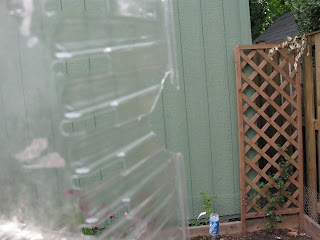 Two of you asked for my pizza recipe, so here it is! I first started making my own pizza dough b/c I was a poor, single grad student that lived alone. This meant that delivery was often out of my price range and that I had a lot of free time after a long day of studying (last thing I want to do after studying is hang around people. My brain is mush & making conversation just isn't going to happen). So, I started making my own pizza dough and stuffed won tons (for won ton soup). These tedious, repetitive tasks were a nice way for me to relax.
Two of you asked for my pizza recipe, so here it is! I first started making my own pizza dough b/c I was a poor, single grad student that lived alone. This meant that delivery was often out of my price range and that I had a lot of free time after a long day of studying (last thing I want to do after studying is hang around people. My brain is mush & making conversation just isn't going to happen). So, I started making my own pizza dough and stuffed won tons (for won ton soup). These tedious, repetitive tasks were a nice way for me to relax.I think this crust is best simply topped with fresh tomato (this time from our CSA & garden!), basil (CSA) and mozzarella (I'll also describe how I do that) but by all means put whatever you want on it!
This makes 2 12-inch pizzas or one very large pizza. I use a KitchenAide Mixer now for the kneading but did it by hand in my grad school days. The good news is that I don't think it's possible to overwork pizza dough, especially by hand, so err on the side of too much rather than too little. This looks time consuming but the total hands-on time is probably close to 30 minutes.
Ingredients:
For dough
1 tsp sugar
1 Tbsp sugar
1.25 c warm water
1 packet of dry yeast
3 c all-purpose King Arthur White Wheat flour, divided (or regular all-purpose flour)
1 Tbsp olive oil
1 tsp salt
Cooking spray
dried oregano, optional
dried basil, optional
garlic powder, optional
For toppings
1-2 large, tomatoes, cored & sliced thin
1 bunch of basil, torn or chopped
salt & pepper
2 cloves of garlic, minced
mozzarella
parm
Directions
- Put tap water in Mixer bowl (or other good-sized bowl). This water should be bath-water temperature and not hotter. If it's too hot for you, it's too hot for yeast! Pour in yeast & sugar and dissolve. Let stand 5 minutes. If after 5 minutes there's a bit of foam on top and the mixture smells like bread, your yeast survived. If it doesn't look any different, start over using cooler water.
- Lightly spoon in 2.75 cups of the flour, the olive oil, salt and, if you're wanting a flavored crust, now's the time to add in your oregano, dried basil, and/or garlic powder. Oh, and I add in an extra 1 Tbsp of sugar b/c I like sweeter crust a la Pizza Hut (yes. shut up). Stir to combine.
- At this point, if you're kneading by hand, dust your work surface (and hands) with flour and turn out the dough. You should knead for about 10 minutes or until the dough is elastic. Add the remaining flour 1 Tbsp at a time, if the dough feels wet. When done, roll dough into a ball, turning the bottom of the ball into itself (kinda like when you converted your Popple back into an innocent-looking "ball").
If you're using you stand mixer, then just turn on low and then medium speed with your dough hook attachment. I don't leave my mixer for this...the mixer can act like your washing machine when all the towels get on one side! Mix for about 5 or so minutes or until the dough is really elastic, adding in the extra flour 1 Tbsp at a time as needed. When done, roll dough into a ball, turning the bottom of the ball into itself (kinda like when you converted your Popple back into an innocent-looking "ball"). In a large bowl, spray cooking spray. Put dough ball in the bowl and spray the top of it with cooking spray. Put plastic wrap over dough (making contact with the dough itself) and place in a warm spot for an hour. Note: You could totally do the above in the morning & let the dough rise all day. Up until this point, the total hands-on time is about 20ish minutes if you are kneading by hand.
When the dough has doubled, preheat the oven to 450*F, punch it down and spread out to the size of your pizza pan. There are many ways to do this (rolling pin, stretching, throwing up in the air!) so experiment & see what works for you. Put pizza in your pan
- Bake the pizza nekkid for 10 minutes.
- Meanwhile, drain your marinated tomatoes & dry them off as much as possible.
- After the 10 minutes, remove the pizza from the oven & drop the temperature down to 400*F. Top you pizza with whatever you like (I'm doing tomatoes first then mozzarella on top) but leave fresh basil for the end.
- Put pizza back into the oven & bake for 20 min or until cheese starts to get golden and the underside of the crust is brown & crispy.
- Let pizza cool at least 5 minutes before cutting into it. (Hot cheese is like lava. Trust me on this one!)

























